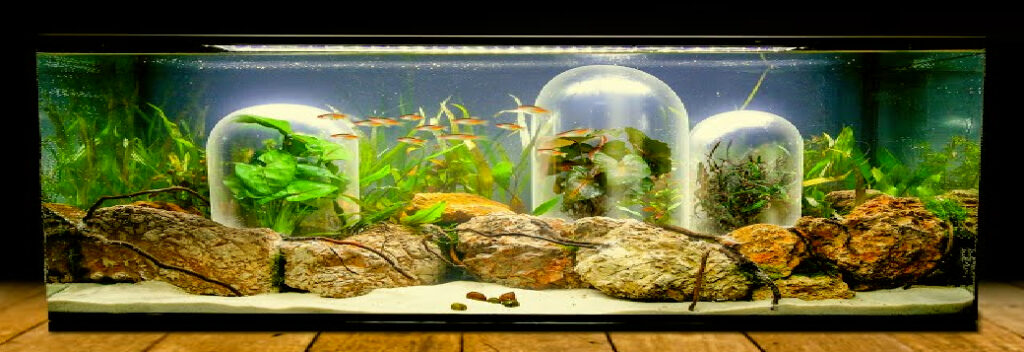Planning Your Aquatic Paradise: Essential Preparations for Keeping an Aquarium

Captivated by the vibrant underwater world? Setting up a home aquarium can be a rewarding experience, offering a mesmerizing glimpse into aquatic ecosystems. However, creating a thriving underwater environment requires careful planning and preparations for keeping an aquarium at home. This guide equips you with the essential knowledge to embark on your aquatic adventure, ensuring the well-being of your finned companions.
Choosing the Right Aquarium
The first step in your aquatic journey involves selecting the perfect aquarium. Aquariums come in various sizes, shapes, and materials, each suited to specific needs. Here are some key considerations when making your choice:
- Size: The size of your aquarium directly impacts the types and number of fish you can house. Beginners are often advised to start with a smaller aquarium (around 10-20 gallons) as it’s easier to maintain.
- Shape: Rectangular aquariums are the most common and offer versatility in placement. However, corner aquariums can add a unique visual element to your space.
- Material: Glass aquariums are the standard choice, offering excellent clarity. Acrylic aquariums are lighter and more resistant to scratches, but may be more expensive.
Remember, a larger aquarium requires a greater commitment in terms of maintenance and cost. Choose an aquarium size that aligns with your experience level, available space, and budget.
Gearing Up: Essential Equipment for Your Aquarium
Once you’ve chosen your aquarium, it’s time to gather the necessary equipment to create a healthy aquatic environment. Here are some key items:
- Filtration System: A reliable filtration system is the backbone of a healthy aquarium. It removes harmful toxins produced by fish waste and uneaten food, mimicking the natural cleaning processes of aquatic ecosystems.
- Lighting System: Aquarium lighting serves two purposes: providing essential light for your fish and plants and enhancing the visual beauty of your underwater world. Choose lighting appropriate for the types of fish and plants you intend to keep.
- Substrate: The substrate, also known as aquarium gravel, provides a natural habitat for some fish species and beneficial bacteria that contribute to a healthy aquarium environment. Choose a substrate size and type suited to the needs of your chosen fish.
- Heater (or Chiller): Depending on the fish species you select, you might need a heater to maintain a specific water temperature range. Conversely, some tropical fish require chillers to keep the water cool enough.
Preparations for keeping an aquarium also involve selecting the right decorative elements like rocks, driftwood, and plants. These can enhance the aesthetics of your aquarium while providing hiding places for some fish species.
Setting Up Your Aquarium: Creating a Thriving Ecosystem
With your equipment assembled, it’s time to set up your aquarium. Here’s a general guideline:
- Clean and Rinse: Thoroughly clean your aquarium with water only (no soap!) to remove any dust or debris. Rinse the substrate thoroughly to remove any dirt or cloudiness.
- Assemble the Filter and Heater: Follow the manufacturer’s instructions to properly assemble and install your filtration system and heater (or chiller) inside the aquarium.
- Add the Substrate: Gently spread a layer of substrate on the bottom of the aquarium, ensuring an even distribution.
- Decorate Your Underwater World: Arrange rocks, driftwood, and plants according to your desired layout. Remember to create hiding places for fish and ensure adequate swimming space.
- Fill the Aquarium: Slowly fill your aquarium with dechlorinated tap water, leaving a few inches of space at the top to prevent overflowing when adding decorations.
Preparations for keeping an aquarium at home involve a crucial step: allowing the aquarium to cycle. This process involves establishing beneficial bacteria that break down harmful ammonia and nitrite produced by fish waste. Cycling your aquarium can take several weeks, so be patient before introducing any fish.
The Inhabitants: Choosing Fish and Other Aquatic Life
Once your aquarium has completed its cycle, you can finally welcome your finned companions! Here are some factors to consider when choosing fish:
- Compatibility: Not all fish species get along. Research the compatibility of different fish to avoid creating a stressful environment where some fish might bully or even eat others.
- Temperament: Consider the temperament of the fish you’re interested in. Are they peaceful community fish, or do they require a solitary environment?
- Water Requirements: Different fish species have specific water temperature and hardness preferences. Choose fish that thrive within the parameters of your aquarium setup.
Remember, start small when introducing fish. It’s always best to gradually add new inhabitants to allow the biological filter to adjust to the increased bioload.
Maintaining Your Thriving Ecosystem
- Discuss the importance of regular water changes and how often they should be performed.
- Explain how to monitor water parameters like temperature, pH, ammonia, nitrite, and nitrate levels using test kits.
- Briefly mention the importance of feeding your fish a healthy diet at appropriate intervals.
Additional Tips for Beginners
- Briefly discuss the benefits of live plants in an aquarium and offer some beginner-friendly plant options.
- Offer advice on preventing and dealing with common aquarium problems like algae outbreaks or fish diseases.
- Encourage responsible pet ownership by mentioning the lifespan of fish and the commitment required to care for them properly.
Conclusion
- Briefly summarize the key takeaways from the article, reiterating the importance of careful planning and preparations for keeping an aquarium at home.
- End with an encouraging message, highlighting the joys of watching a thriving underwater world flourish in your care.
Smi Shohag
